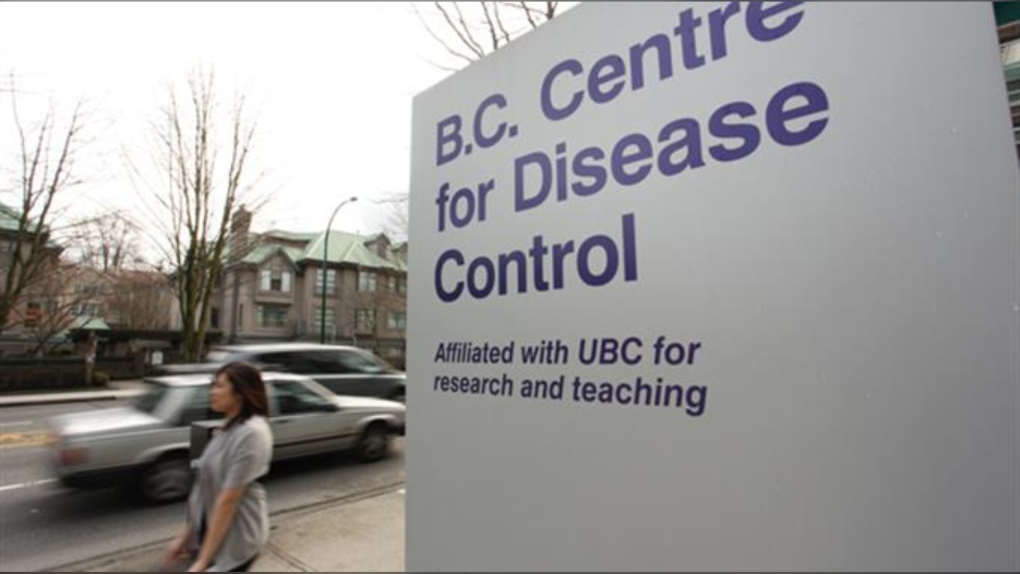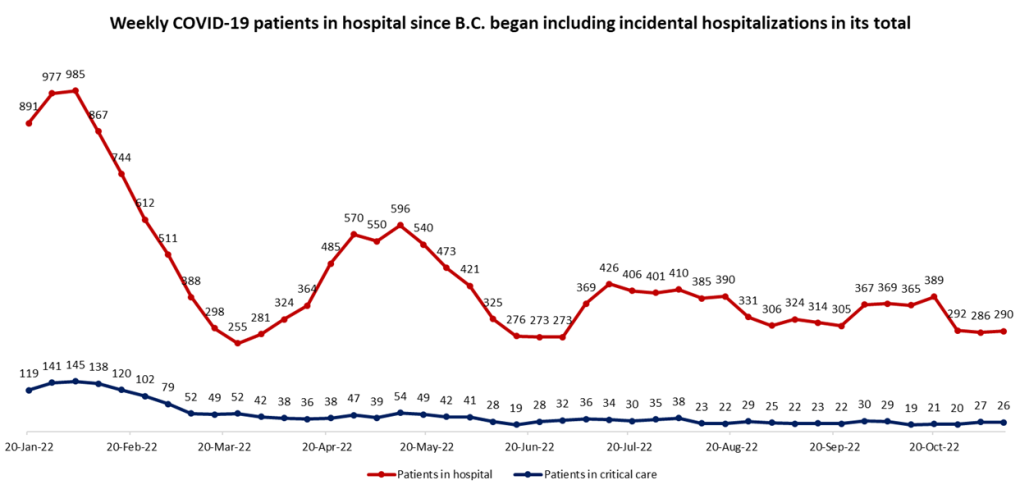B.C. COVID-19 numbers remain low as 'fall surge' comes for other diseases
 A sign at the BC Centre for Disease Control is seen in this photo from the BCCDC website.
A sign at the BC Centre for Disease Control is seen in this photo from the BCCDC website.
For the third week in a row, the B.C. Centre for Disease Control has reported its lowest weekly COVID-19 case total of 2022.
From Oct. 30 to Nov. 5, according to Thursday's update, the BCCDC detected just 407 new infections, a number that is artificially low – likely by at least 100-fold – because it only includes lab-based test results and excludes reinfections.
Still, the declining official case count matches stable or declining numbers of new hospital admissions and current hospitalizations, as well as stable concentrations of coronavirus in Lower Mainland wastewater, suggesting the long-forecast fall surge of COVID-19 infections has yet to materialize.
 The number of people in hospital on Thursdays in B.C. since the province switched to a "hospital census" model is shown. (CTV)
The number of people in hospital on Thursdays in B.C. since the province switched to a "hospital census" model is shown. (CTV)
As seen in the graph, there were 290 people in hospital with COVID-19 in B.C. as of Thursday. That's essentially unchanged from where the hospital population has been for the last three weeks.
Hospitalization totals in B.C. include both those who have serious cases of COVID-19 requiring hospital care and those who are admitted to hospital for other reasons and test positive incidentally.
Health officials have previously said between 40 and 50 per cent of hospitalizations are caused by COVID-19, while the rest are incidental.
Since the province switched to this "hospital census" model for counting COVID-19 hospitalizations, there have been as many as 985 and as few as 255 COVID-19 patients in B.C. hospitals on Thursdays.
OTHER VIRUSES ON THE RISE
While B.C.'s COVID-19 data does not show signs of an ongoing surge, federal health officials warned Wednesday that RSV and influenza have surpassed seasonal averages, with children and teenagers accounting for roughly half of the cases.
That surge, along with the continued spread of COVID-19 and increases in the prevalence of Omicron variants BQ.1.1 and BF.7, prompted Canada's top doctor to urge the wearing of face masks indoors.
"Although no individual layer of protection is perfect, when used consistently and together, vaccine plus layers can provide excellent protection against COVID-19 as well as other infectious diseases we may encounter," said Dr. Teresa Tam, Canada's chief public health officer, during her update Wednesday.
In B.C., data on doctor visits for symptoms of respiratory illness has shown a steady increase since early September, though visit rates remained below historical averages as of the end of October.
As with the national numbers, children and teenagers account for much of the surge in visits for respiratory symptoms in B.C.
Last week BC Children's Hospital activated its emergency operations centre amid a rise of visits to its emergency room.
COVID-19 remains the most-detected respiratory illness in B.C., even with the well-documented undercounting of infections, according to BCCDC data on confirmed cases of respiratory diseases.
However, other viruses have been detected in increasing numbers in recent weeks, while all of the available indicators for COVID-19 have suggested steady or declining transmission.
VACCINATION DATA
Both Tam and local health officials have urged the public to get vaccinated against the flu and COVID-19 this fall.
While the BCCDC doesn't publish regular data on influenza vaccine uptake, it does release weekly totals for COVID-19 vaccine doses administered.
There were 160,024 such shots given in B.C. during the week of Oct. 30 to Nov. 5, a decrease of a little more than 16,000 from the previous week.
Most of the doses administered during the period – 89,267 of them, or about 56 per cent – are considered fourth doses by the BCCDC, meaning they were administered to people who had already had a main series of vaccine doses, plus a booster.
Only a small portion of the total – 10,221 doses, or about six per cent – is listed in the "third dose" category, meaning it went to people who had not yet had a first booster shot.
CTVNews.ca Top Stories

Labour minister unveils steps to end Canada Post strike
Canada Post workers began their strike four weeks ago, halting mail and package deliveries across the country. Labour Minister Steven MacKinnon said he hopes work will resume as early as next week.
'Little girl deserves justice': Gallery erupts in anger as charges stayed against driver who killed child
In a tense courtroom, a judge stayed the charge against a Saskatoon woman who hit and killed a nine-year-old girl.
Skier who went missing at Sun Peaks Resort found dead
In a tragic turn of events, the 68-year-old man who went missing while skiing at Sun Peaks Resort earlier this week has been found dead, the RCMP confirmed Friday.
Canada's homicide rate down in most provinces, with 2 exceptions
The homicide rate is declining in Canada, and the country's three largest cities all saw double-digit percentage decreases in homicides per capita, according to data released this week.
Dreaming of a white Christmas? Here are the Canadian cities where snow has been a sure thing
With fewer than two weeks remaining until Christmas Day, weather forecasts and snowfall projections are starting to take shape but have yet to be finalized for cities across Canada.
'They believe in diplomacy, good luck': Doug Ford doubles down on energy threat as some premiers distance themselves
Doug Ford is standing behind his threat to stop providing the U.S. with electricity in response to president-elect Donald Trump's promised tariffs, even as several other premiers publicly distance themselves from the stance.
'He was done with shopping': Video shows dog laying on horn in B.C. mall parking lot
Malls can be hectic around the holidays, and sometimes you just can't wait to get home – whether you're on two legs or four.
Trump wants to turn the clock on daylight saving time
U.S. president-elect Donald Trump wants to turn the lights out on daylight saving time.
Mysterious googly eyes go viral after appearing on public art in Oregon
Googly eyes have been appearing on sculptures around the central Oregon city of Bend, delighting many residents and sparking a viral sensation covered widely by news outlets and featured on a popular late-night talk show.
































